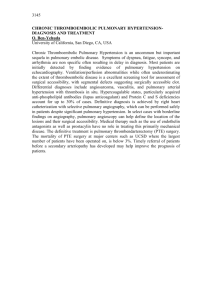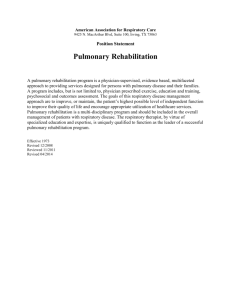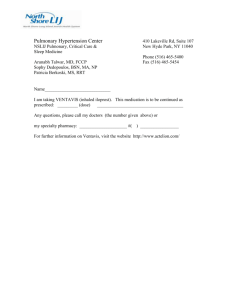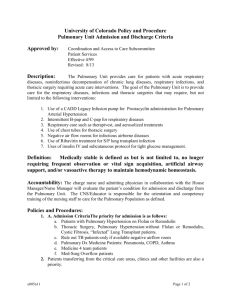Pulmonary Thromboembolism
advertisement
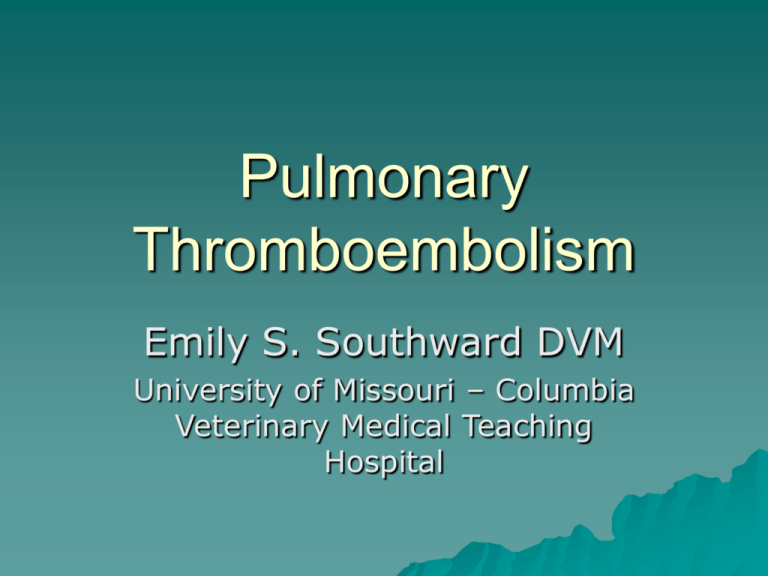
Pulmonary Thromboembolism Emily S. Southward DVM University of Missouri – Columbia Veterinary Medical Teaching Hospital Definition Pulmonary thromboembolism – One clot or many clots that form at distant sites and lodge in the pulmonary vasculature. Pulmonary artery thrombus – Clots that form in the pulmonary vasculature. Clots can partially or fully occlude pulmonary vessels. Virchow’s Triad Venous stasis. Injury or abnormalities to the vessel wall. Alterations in coagulation properties. Venous Stasis Accumlation of activated procoagulants. – Immobilization – Inadequate cardiac pump. Promotes thrombus formation. Vessel Wall Injury Acute or chronic injury to vessel endothelium. Leads to activation of platelets and clotting cascade. Promotes thrombus formation. Vessel Injury Platelet Adhesion Aggregation Alternations in Coagulation Increase in procoagulant factors. – By trauma to vascular wall or extravascular tissues. – Releases tissue thromboplastin and phospholipid. – Leads to formation of prothrombin activator. – Prothrombin Thrombin Alterations in Coagulation Decrease in anticoagulant factors. – Thrombomodulin – Antithrombin III – Heparin – Alpha2-Marcoglobulin – Plasmin Leads to hypercoagulable state by formation of thrombin. Thrombosis Formation Platelet nidus at site of injury. Growth by aggregation of platelets and fibrin. Activation of clotting cascade. Larger growth to a red fibrin thrombus. Thrombus fractures and embolizes to other areas of the body. Predisposing Factors or Diseases for Development of PTE Hypercoagulable state – Nephrotic syndrome – Immobilization – Amyloidosis – Early DIC – Hyperadrenocorticism Capillary fragility Activation of clotting cascade. Predisposing Factors or Diseases for Development of PTE Hypercoagulable Capillary fragility state – Diabetes Mellitus – Immune–mediated hemolyitc anemia – Sepsis – Hyperadrenocorticism Activation of clotting cascade. Predisposing Factors or Diseases for Development of PTE Hypercoagulable Capillary state fragility Activation of clotting cascade. – Sepsis – Pneumonia/pyothorax – Heartworm disease – Surgery – Bacterial endocarditis – Neoplasia Consequences of PTE Respiratory. – Increased alveolar dead space. – Hyperventilation. – Hypoxemia. – Ventilation/perfusion inequality. – Intrapulmonary shunts. Normal Alveolus Increased Alveolar Dead Space Hypoxemia Results from ventilationperfusion inequality, physiologic shunting and increased dead space. Intrapulmonary Shunts Blood that has not been to areas of ventilated lung and enters systemic circulation without gas exchange taking place. Poorly oxygenated blood enters the arterial system lowering the PaO2. Not responsive to oxygen therapy. Ventilation/Perfusion Inequality V/Q inequality occurs when distribution of blood is altered to the alveoli. O2 increase in the alveoli and CO2 decreases. Hemodynamic Changes Increase in pulmonary vascular resistance. Increased afterload to the right heart. Can lead to circulatory collapse and shock. Clinical Signs Not pathognomonic. – Dyspnea. – Tachypnea. – Hemoptysis. – Tachycardia. – Hypoxemia. – Sudden death. Diagnosis CBC/Biochemistry results reflect primary disease process. Hypoxemia common but 10% of patients are normal. Thoracic radiographs can be normal and inconclusive. LaRue MJ and Murtaugh RJ. Pulmonary Thromboembolism in Dogs:47 cases (1986-87). J Amer Vet Med Assoc. 1990 Nov. 15;197(1):13681372. Johnson LR et al. Pulmonary Thromboembolism in 29 dogs:1985-1995 J Vet Intern Med. 1999 Jul;13(4):338-345. Flükiger MA and Gomez JA. Radiographic Findings in Dogs with Spontaneous Pulmonary Thrombosis or Embolism. Veterinary Radiology, Vol.25,No.3 124-131. Advanced Diagnostics Pulmonary scintigraphy Pulmonary angiography. Pulmonary Scintigraphy Noninvasive Aids in diagnosis of PTE but not definitive. Two types- ventilation and perfusion scans. Perfusion Scan Performed first. Normal study rules out PTE. Radionuclidelabelled, macroaggregated albumin in peripheral vein. Ventilation Scan Inhaled radioactive inert gas-senon133 or technetium99m. Patient under general anesthesia. Normal in PTE. Ventilation/Perfusion Combo With PTE the ventilation scan would be normal and the perfusion scan abnormal. Suggestive of PTE.F Picture from WWW.bschsys.org/DiagnositcImaging/nucmd /htm Normal Human Perfusion Scan Abnormal Human Perfusion Scan Pulmonary Angiography Performed if definitive diagnosis or exclusion of PTE is required. Requires sedation or general anesthesia. Greater risks. Intraluminal filling defect and sharp cutoff are diagnostic for PTE. Pulmonary Embolus Human lung. Arrow indicates abrupt termination of a pulmonary artery. Www.brighamrad.Harvard.edu/cases/b wh/images. Treatment Oxygen therapy. Heparinization 200-300 units/kg subcutaneously every 8 hours. Streptokinase or TPA. Mechanical ventilation. Long term- warfarin therapy. Monitoring Clotting times- want to maintain PTT at 1.5-2.5 times normal or and ACT at 1.2-1.4 times normal. Serial arterial blood gas analysis. Respiratory rate. Central venous pressure. All other basic monitoring. Complications Of Therapy Hemorrhage most common. Not predictable. Protamine therapy indicated with hemorrhage due to heparin. Vitamin K or fresh-frozen plasma in warfarin therapy. Prognosis Guarded. Improves with early detection and treatment. Improves each day the patient survives. At risk for more emboli. UMC VMTH Cases Three in data base. – Sadie – Magnum – Koko Sadie Bailey 8-year-old FS mixed breed dog. Presented for weight loss, anemia, and anorexia. Weak and lethargic on presentation Hemoabdomen, thrombocytopenia, and neutrophilia with left shift. Developed severe dyspnea and ventricular tachycardia. Sadie’s Thoracic Films Sadie’s Thoracic Films Sadie’s Necropsy Hepatocellular carcinoma Adrenocortical hyperplasia Pulmonary thrombois – most lobar branches effected. Renal infarction. Magnum Meeks 8-year-old MC doberman pinscher Presented for dyspnea of two days duration. Protein losing nephropathy. Magnum’s Thoracic Films Magnum’s Thoracic Films Koko Westerhoff 12-year-old FS dachshund. Presented for lethargy, anorexia, tachypnea, and possible CHF. History includes diabetes mellitus, IVDD and cataracts. PE- Increased BV lung sounds, mild crackles, tachycardia, and left systolic murmur. Koko’s Thoracic Films Koko’s Thoracic Films Koko’s Pefusion Scintigraphy Koko’s Pefusion Scintigraphy Koko’s Necropsy Muliple small thrombi in the pulmonary vasculature. Cardiomegaly Thanks Dr. Mann Dr. Dodam Dr. Lattimer Dr. Kunz Questions?
